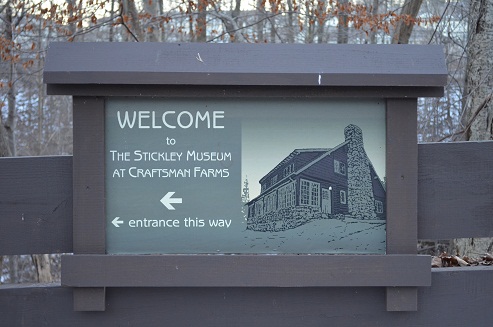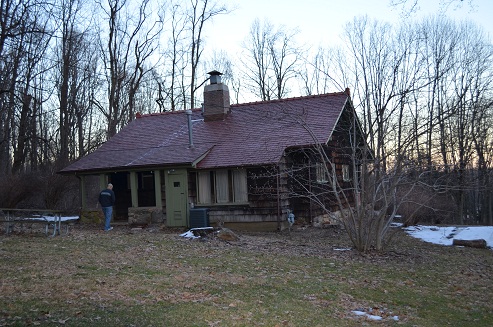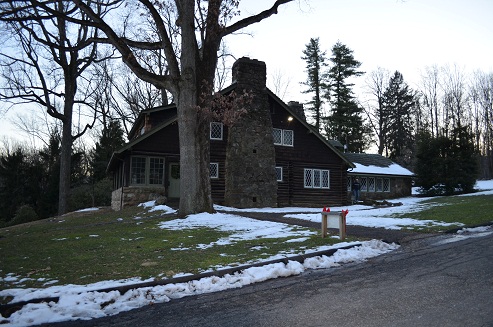Gustav Stickley – A Founder of the Arts and Crafts movement in the USA
Heading home to Alexandria Virginia, we only needed to veer slightly to the east in order to experience one of the most notable Craftsman Farms in the USA. We weren’t disappointed. I took lots of photos as I plan to capture the site with pen and watercolor.
Craftsman Farms is the former country estate of noted turn-of-the-century designer Gustav Stickley, a major proponent of the Arts and Crafts movement in decorative arts, home building and furnishing styles. Stickley combined the roles of designer and manufacturer, architect, publisher, philosopher, and social critic. He is best known today for his straightforward furniture, sometimes called “mission” or “Craftsman” furniture.

Around 1905 Stickley moved his headquarters from Syracuse to New York City. In 1908 he began acquiring 650 acres of property on what is now the western edge of Parsippany-Troy Hills, an area formerly part of Morris Plains where he envisioned establishing a farm school for boys. The focal point of his “Garden of Eden” was a large house constructed of round, hewn chestnut logs that were cut from the property’s woods and local stone also found on the property.
Stickley originally designed the main house at Craftsman Farms as a “club house,” a gathering place for workers, students and guests. In its huge kitchen, meals could be prepared for 100 people. The living and dining rooms, reaching fully 50 feet and warmed by copper-hooded fireplaces, made ideal meeting rooms. The porch opened to a vista of the farm and brought in light and air. The house is T-shaped, with a one-story kitchen attached to the rear. The large gabled roof has long shed dormers at the front and back, which allow for light and ventilation in the bedrooms. The Log House is now widely considered to be one of the most significant landmarks of the American Arts and Crafts movement.
Craftsman Farms exemplifies Stickley’s philosophy of building in harmony with the environment by using natural materials. To quote from Stickley’s magazine, The Craftsman (November 1911): “There are elements of intrinsic beauty in the simplification of a house built on the log cabin idea. First, there is the bare beauty of the logs themselves with their long lines and firm curves. Then there is the open charm felt of the structural features which are not hidden under plaster and ornament, but are clearly revealed, a charm felt in Japanese architecture….The quiet rhythmic monotone of the wall of logs fills one with the rustic peace of a secluded nook in the woods.”


Stickley designed Craftsman Farms to be self-sufficient, with gardens for vegetables and flowers, orchards, dairy cows and chickens; the produce grown on the farm was used in the restaurant operated by Stickley as part of his furniture showroom and department store in Manhattan. Stickley commuted to his New York showroom by train from Morris Plains.
Stickley and his family lived at Craftsman Farms until 1915, when he filed for bankruptcy after several years of financial difficulties. By then the taste of the American people that 15 years earlier had embraced the clean, strong lines of Craftsman furniture changed once again, this time towards the revival of early American and other styles. But Gustav Stickley made a lasting impression on American decorative arts. It is difficult to realize what a revolutionary step his designs were without keeping in mind the crowded, highly embellished interiors of the Victorian age that had preceded him. His functional approach to design and his unornamented, clean-lined furniture introduced Americans to the modern decorative arts to come.
Today, Craftsman Farms consists of 30 acres located in and owned by and located in the Township of Parsippany-Troy Hills and it has been designated a National Historic Landmark. The Craftsman Farms Foundation, was formed in 1989 to protect and preserve the property. The Foundation operates the site as the Stickley Museum at Craftsman Farms.
The 30 park-like acres include meadows, wooded areas, walking trails, a pond and stream, and several support buildings including a massive stone stable, three cottages, a calf barn, and the ruins of a dairy barn. The Log House has been largely restored to its 1910-1917 appearance and is open to the public for tours.
If you get the chance to visit the farm for yourself and relive the dream that Gustav Stickley had — if only just for a minute – I recommend you take the opportunity, just like we did!
Leisa


